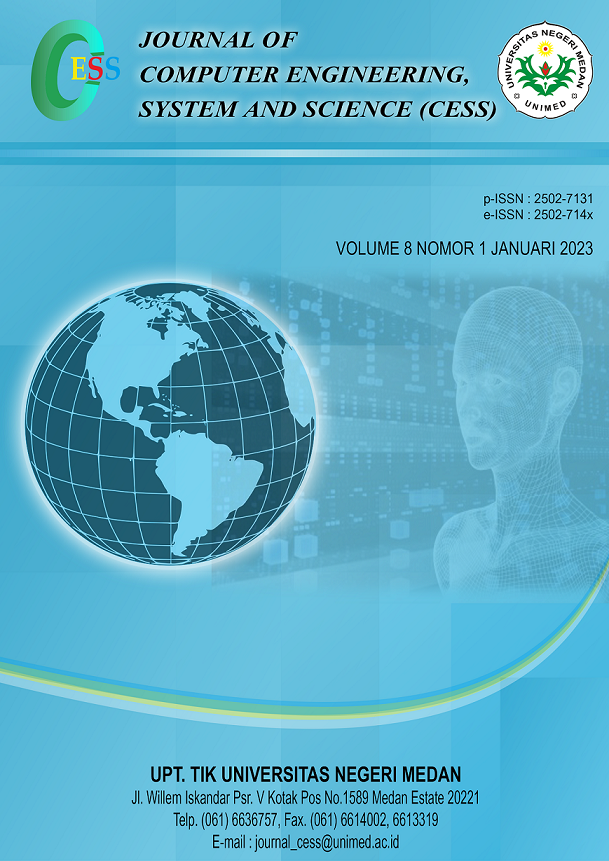Transaction Data Security Using AES and RC4
DOI:
https://doi.org/10.24114/cess.v8i1.41212Keywords:
Digital Data, Data Security, Cryptography, AES, RC4Abstract
This study discusses the effectiveness of using AES (Advanced Encryption Standard) and RC4 (Rivest Chipper 4) as digital data security algorithms to prevent and protect transaction data from irresponsible parties. This needs to be done because the development of sales transactions or other services has used digital technology a lot. This situation causes the need to secure digital data from existing transactions, so that transaction data can be stored safely. Transaction data security is carried out by changing data into ciphers or codes that are difficult to read using the AES (Advanced Encryption Standard) and RC4 (Rivest Cipher 4) algorithms. This research begins by collecting existing transaction data and then transforming it into ASCII code. The results of the transformation will be used to perform calculations using the AES algorithm. After completing the calculation process using the AES algorithm, then do the calculations using RC4. These results will be stored in the database so that the transaction data that has turned into these codes cannot be known by other parties. The combination of the AES and RC4 algorithms is carried out to strengthen data encryption because there are more and more rotation systems and double security is carried out so that digital data is not easily read and misused. With the presence of this research, it can be shown that the AES and RC4 algorithms are capable of encrypting existing transaction data with multiple levels of security.References
A. Utama and R. F. Siahaan, œPenerapan Kriptografi untuk Pengamanan Data Transaksi Deposito pada Easy Tronik dengan Metode RC-5, vol. 3, no. 3, pp. 29“39, 2021.
Widiarti, Azaanudin, and Elfitriani, œImplementasi Kriptografi Pengamanan Data Nilai Siswa, vol. 21, no. 1, 2022.
L. Mustika, œImplementasi Algoritma AES Untuk Pengamanan Login Dan Data Customer Pada E-Commerce Berbasis Web, vol. 7, no. 1, pp. 148“155, 2020.
T. Hidayat, œENCRYPTION SECURITY SHARING DATA CLOUD COMPUTING BY USING AES ALGORITHM : A SYSTEMATIC REVIEW, vol. 2, no. 2, 2019.
C. Kirana and E. Sugianto, œPenerapan Algoritma AES dan Konversi SMS ke dalam Bahasa Khek pada Aplikasi Enkripsi Berbasis Mobile Application, vol. 5, no. 1, pp. 68“77, 2019.
R. S. Siregar, M. S. Asih, and N. Wulan, œPENERAPAN ALGORITMA RC4 DAN RAIL FENCE UNTUK ENKRIPSI DATABASE MAHASISWA PADA KAMPUS POLTEKKES KEMENKES MEDAN, vol. 7, no. 2, pp. 51“56, 2019.
R. Rivaldi, T. Informatika, F. T. Informasi, U. B. Luhur, P. Utara, and K. Lama, œIMPLEMENTASI PENGAMANAN DATA ARSITEKTUR MENGGUNAKAN METODE KRIPTOGRAFI DENGAN ALGORITMA, vol. 4, no. 2, pp. 63“67, 2021.
P. S. Ramadhan, œPENERAPAN EUCLIDEAN PROBABILITY DALAM PENDETEKSIAN PENYAKIT IMPETIGO, vol. 4, no. 1, pp. 11“16, 2019.
D. Boneh and V. Shoup, œA Graduate Course in Applied Cryptography, 2020.
O. Dakhi, M. Masril, R. Novalinda, and J. Ambiyar, œAnalisis Sistem Kriptografi dalam Mengamankan Data Pesan Dengan Metode One Time Pad Chiper, vol. 20, no. 1, pp. 27“36, 2020.
P. Burciu, œAn Efficient ( Low Resources ) Modular Hardware Implementation of the AES Algorithm, vol. 5, no. 17, pp. 1“10, 2019.
C. Lin, G. Hu, C. Chan, and J. Yan, œapplied sciences Chaos-Based Synchronized Dynamic Keys and Their Application to Image Encryption with an Improved AES Algorithm, 2021.
T. M. Kumar, K. S. Reddy, S. Rinaldi, B. D. Parameshachari, and K. Arunachalam, œA Low Area High Speed FPGA Implementation of AES Architecture for Cryptography Application, 2023.
D. W. Ahmed, T. M. Jawad, and L. M. Jawad, œAN EFFECTIVE COLOR IMAGE ENCRYPTION SCHEME BASED ON DOUBLE PIECEWISE LINEAR CHAOTIC MAP METHOD AND RC4 ALGORITHM, vol. 16, no. 2, pp. 1319“1341, 2021.
J. Zhang, H. Liu, and L. Ni, œA Secure Energy-Saving Communication and Encrypted Storage Model Based on RC4 for EHR, vol. 8, pp. 38995“39012, 2020.
R. Saha, G. Geetha, W. J. Buchanan, and T. Kim, œMRC4 : A Modified RC4 Algorithm Using Symmetric Random Function Generator for Improved Cryptographic Features, IEEE Access, vol. 7, pp. 172045“172054, 2019.
Downloads
Published
Issue
Section
License
Copyright (c) 2023 CESS (Journal of Computer Engineering, System and Science)

This work is licensed under a Creative Commons Attribution 4.0 International License.










